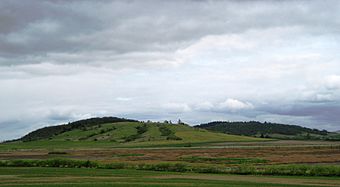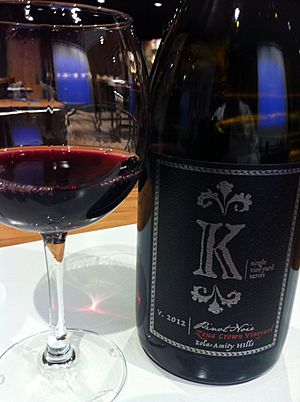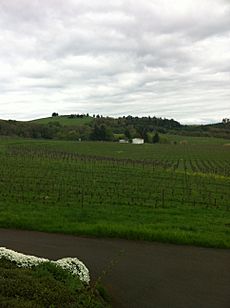Eola-Amity Hills AVA facts for kids
| Wine region | |

Eola Hills north of Dallas in Polk County
|
|
| Type | American Viticultural Area |
|---|---|
| Year established | 2006 |
| Country | United States |
| Part of | Oregon, Willamette Valley AVA |
| Climate region | Maritime |
| Total area | 37,900 acres (15,338 ha) |
| Size of planted vineyards | 1,244 acres (503 ha) |
| No. of vineyards | 95 |
| No. of wineries | 25 |
The Eola-Amity Hills AVA is a special area in Oregon, United States, known for growing grapes. AVA stands for American Viticultural Area, which means it's a recognized grape-growing region. This area is found in Polk and Yamhill counties.
It's part of a larger region called the Willamette Valley AVA. The Eola-Amity Hills stretch from the town of Amity in the north to the city of Salem in the south. The hills themselves are about 15 miles (24 km) long and 6 miles (10 km) wide.
One cool thing about this area is the wind! Steady winds blow in from the Pacific Ocean. They come through a gap in the Oregon Coast Range called the Van Duzer Corridor. These winds help keep the summer temperatures just right for the grapes. The Eola Hills got their name from a nearby community called Eola. That name comes from Aeolus, who was the Greek god of the winds.
Climate and Geography of Eola-Amity Hills
The Eola-Amity Hills has about 2,400 acres (971 ha) of land planted with grapevines. Like most of the Willamette Valley, this area has a maritime climate. This means it has mild winters. The summers are cooler and a bit wetter compared to some other grape-growing regions.
The climate here is greatly affected by the Pacific Ocean. Cool air from the Pacific comes through the Van Duzer Corridor. This gap is between the Oregon Coastal Range and the Cascade Range to the east. This cool air travels over 30 miles from the west in the afternoons. It helps to cool down the region, which is important for the grapes. Cooler temperatures help the grapes keep higher levels of acidity, which is good for their flavor.
Most of the rain in the Eola-Amity Hills falls between October and April. The main growing season for grapes is usually quite dry. However, harvest time, which is in late September and October, can sometimes bring rain. This rain can cause problems like grape rot. It can also make the grapes too watery if the vines absorb too much water from the wet soil. Also, migrating birds flying south for winter sometimes eat the ripening grapes.
The soil in the Eola-Amity Hills is special. It includes volcanic soils and shallow nekia series. These soils are found over old basalt rock layers. You can also find soil deposits left behind from the ancient Missoula floods throughout the area.
Vineyards and Grapes
The Eola-Amity Hills was officially recognized as its own AVA in 2006. Before that, many famous vineyards in this area were already growing grapes. These grapes were used by wineries in other parts of Oregon.
One of the first vineyards planted here was Bethel Heights Vineyard. It's located northwest of Salem. A grape-growing pioneer named Victor Winquist planted it in 1977.
Some other well-known vineyards in the Eola-Amity Hills include:
- Temperance Hill Vineyard: This vineyard has 100 acres and is northwest of Salem.
- Zenith Vineyard: This one was first planted in 1982.
- Zena Crown: Located in the middle of the Eola-Amity Hills, it has 83.5 acres. Grapes were first planted here in 2003.
Today, there are 95 vineyards and 26 wineries in the Eola-Amity Hills AVA. About 20 of these wineries have tasting rooms where people can visit.
The most common type of grape grown here is Pinot noir. There are over 1,721 acres of Pinot noir grapes. Other grapes grown in smaller amounts include Chardonnay (66.4 acres) and Pinot gris (48 acres). You can also find small plantings (less than 10 acres each) of Riesling, Muscat, Syrah, Dolcetto, Tempranillo, Auxerrois, Viognier, Pinot blanc, Gewürztraminer, and Carmine grapes.
In 2013, a company called Jackson Family Wines bought the Zena East and Zena Middle vineyards. These vineyards had 42.5 acres (17.2 ha) of Pinot noir grapes. This was a big deal because it was one of the first times a large California winemaker bought a lot of vineyard land in Oregon.



